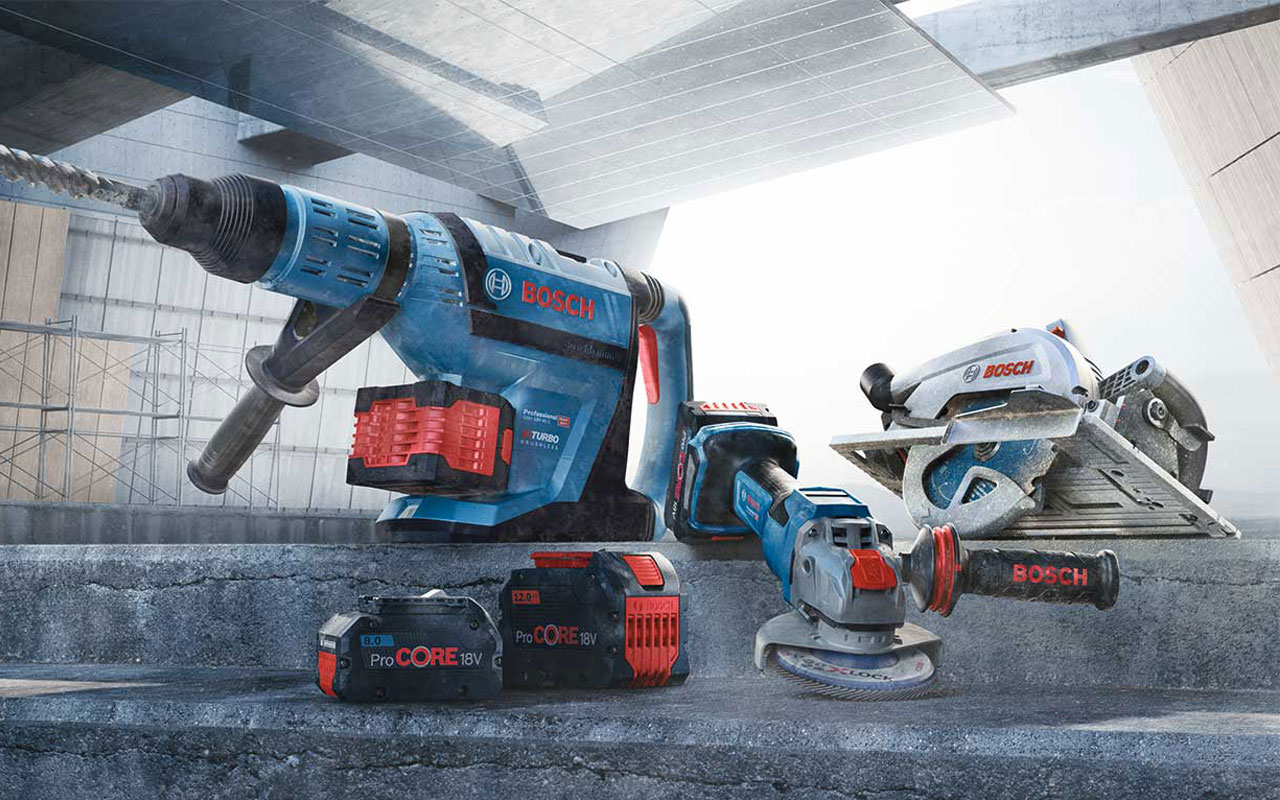A leading fitness equipment maker hits its stride with Alloy
The speed and flexibility of Alloy POS analytics enabled this consumer brand to make more timely decisions for new product success and inventory management.
ViewWe’re over 2 years into the COVID-19 pandemic and still living in an era of volatility and uncertainty. For global giant Bosch, that has meant successfully weathering the shift from retail brick and mortar sales, to ecommerce and back.
As Director of the Power Tools division of Bosch Canada, Matthew Bergum needed to take an innovative approach to managing retailer partnerships using POS data in Alloy.ai.
In a recent webinar we sat down with Matthew to explore his best practices for managing Bosch’s sales and promotions strategy using real-time POS data — gathered from across all their ecommerce and retail customers.
Alloy.ai:
You’ve successfully created a data-driven culture on your team at Bosch. Can you speak to some of the change management strategies you leaned into as you tried to get the most out of point of sale data?
Matthew Bergum:
Alloy is a phenomenal tool, but it’s only as good as the data that’s there and those that use it. And it’s because of that mindset shift where, historically, for so many years, we’ve talked about and we’ve used shipment data only, it’s taken a bit of a transformation for our team to collectively start using other sources of data that we use Alloy for.
So a few things that we’ve done over the last year or two — one thing is we created champions. We identified a couple of problems that we wanted to use Alloy to solve and we identified either sales people or people in our marketing team as the champion to figure out how to use Alloy to solve that problem or to improve a process. And once they figure that out, then the idea is for them to share that with the team.
We also work closely with the group at Alloy to understand who on our team is using it, how long they’re using it for, how often, and those sorts of things. Mostly to understand who our real “super-users” are and who we can learn from. It can’t just be one person, it has to be multiple people on the team that are all driving the rest of the organization to use it.
And then the last thing is, I’ve done some simple things like challenges. I’ll challenge our team to — by the end of the week, by the end of the month — use Alloy to find something that you didn’t already know about your business, about your customer, and share that with the team, because it can lead us to some pretty good conversations and help other people on the sales team or marketing team. It turns a light bulb on for them to think about, “Oh, I can use that for my business.”
Alloy.ai:
If you could only look at one thing in Alloy daily, what would it be and why?
Bergum:
I guess if I had to pick one, sales data is obviously the most important thing. There are a lot of different factors that play into that, but to even be more specific than that, considering everything we’ve gone through with the pandemic, one of the nice things about Alloy is every individual user can create their own dashboard specific to the things that they want to see. So my dashboard is very different from any of our individual sales people.
The top box on my dashboard is rolling 52 week sales, 2022 versus 2019. I’m skipping 2020 and 2021 because of all of the exciting things that happened during those years and I really want to keep a pulse on what’s happening versus 2019 as the true health of our business. And so if I had to pick one thing, it’s probably that.
Alloy.ai:
Something that’s been top of mind for you is managing promotions with your customers. Can you tell us a little bit more on the promotions front? What is the challenge or objective, and how are you approaching that?
Bergum:
This is a problem that we are still actively solving within Alloy, and we’re still working through it. It has nothing to do with the ability of Alloy, it’s more getting all the data in the right place and looking at it properly.
But our business is very promotional, and I’m sure many people on this call have similar scenarios where the way that we fund those promotions is through various sorts of POS credits or VFS depending on the retailer. And it’s an accounting nightmare to track and manage all of those credits. We think we know what the customer is going to deduct and they deduct something different five months later.
And so it’s been a manual process for us to track it. And now what we’re working with Alloy on is creating a dashboard that will allow us to upload some more of our internal information to track that for us, “These are the dates of the promotion, this is the item, tell me how many units were sold during the time period and tell me what that POS credit is going to be.” And now we have something that spits out exactly what we need to approve from an accounting perspective or be prepared for that customer to deduct eventually.
It’s very manual for us today, but very confident that we can solve that or make that process much more efficient using Alloy.
Alloy.ai:
Are you doing much on e-commerce price fluctuations? Is that part of the analytics you are looking at?
Bergum:
I guess what we are doing today with Alloy.ai is using it to measure average price. I’m sure many people on this call have gone through various forms of price increases over the last year, and one of the ways that we have to make sure that that’s happening is we also see that same increase on the retail side.
For every single one of our customers, we pull in average price, we pull in the actual retail price that those products are being sold at, and we’re watching average price year over year also climb. Are we doing it on an item level, customer level and comparing across retailers to manage map programs and price wars? No, but we probably could if we really wanted to. The data is all there. It’s not something that we’ve done, but it’s probably possible.
"I'll challenge our team to use Alloy to find something that they didn't already know about their business, about their customer, and share that with the team, because it can lead us to some pretty good conversations and help other people on the sales or marketing team."
Alloy.ai:
So over two years into the pandemic, are you all seeing shifts back to brick and mortar from digital? And what is that kind of trend looking like for you all?
Bergum:
And maybe while people are answering that, just kind of back to the other question about what we’ve seen with the change in the pandemic, another side benefit of working for such a large organization, there’s a lot of reporting up that has to happen, a lot of forms and files to fill out so that our global team can see what’s happening. And this has been a very specific question from every country that we do business in is: “What’s your in-store sales, what’s your digital sales, and how are those changing?”
Without something like Alloy.ai, that would’ve been a very time-consuming task and likely would not have been accurate. So from just an internal reporting perspective, it’s a couple of clicks of a button for us now and we can spit that data out pretty quickly.
Alloy.ai:
We’d be remiss in this conversation not to talk about how you’ve managed the pandemic and how Alloy.ai maybe has played a part there. We know that for a lot of our customers, COVID has really accelerated that shift of business more from brick and mortar to digital and e-commerce. Could you talk about that and any key learnings generally? How have you thought about more effectively managing that shift?
Bergum:
As I’m sure everybody has experienced, digital has exploded over the last couple of years. I would like to say that even before the pandemic, it was obviously very important to us. We knew as our digital business continued to grow, but it has exponentially grown over the last couple of years.
And what Alloy.ai has helped us that, we wouldn’t have been able to do otherwise is really watching that shift from brick and mortar to e-commerce. This is something that we spent a lot of time making sure was explicitly clear in our data — separating in-store sales, true brick and mortar sales from all of the other forms of digital, BOPIS (buy online pickup in store), you name it. We really wanted to see all of those separated out so that we had a true look at our business.
And so, again, I talked about my specific dashboard, another key piece of my dashboard is seeing our year-to-date sales and the percentages of how much of that is happening at brick and mortar, how much of that is happening in digital and BOPIS, and how are those changing year over year. We have seen in ’22, in the last three, four months, we are shifting back to brick and mortar, especially in Canada as lockdowns are lifting up. We now no longer have to wear masks in Ontario. And so we are seeing a lot of that shift back to brick and mortar, however, Alloy.ai also helps us see that our e-comm business is still significantly higher than pre-pandemic.
And so a lot of shifting back and forth, but now we can, again, speak very intelligently about where our customers are shopping and make decisions on resources and the structure and the team on how we have to manage that.
Alloy.ai:
Do you all collect, use, analyze sales data relative to competitors? So competitive data, category data? Is that something you all look at and how do you kind of take advantage of that data?
Bergum:
Yeah, that’s another good question. Honestly, it’s not something that Alloy.ai would really be involved with. Again, the thing to remember is that the data that we put in Alloy.ai 99% of the time is whatever data the customer gives us. So in a normal world, we wouldn’t be receiving any competitive data about our customers.
Share-of-shelf is interesting. That’s something that we also do on the side, but we don’t do that within Alloy.ai. It’s much more as a market share piece. That is a bit of a different animal. So I guess the short answer is no, but something to think about for sure.
The speed and flexibility of Alloy POS analytics enabled this consumer brand to make more timely decisions for new product success and inventory management.
ViewThe global confectioner mitigates waste, improves service levels and controls costs by connecting digital supply chain visibility with POS analytics.
Keep readingHow to take an iterative approach to digital supply chain transformation with real-time alerts that motivate teams to collaborate on issue resolution
Keep reading
